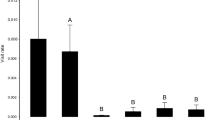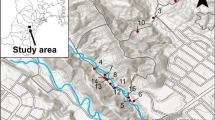Abstract
Plant reproductive success within a patch may depend on plant aggregation through pollinator attraction. For rewardless plants that lack rewards for pollinators, reproductive success may rely strongly on the learning abilities of pollinators. These abilities depend on relative co-flowering rewarding and rewardless plant species spatial distributions. We investigated the effect of aggregation on the reproductive success of a rewardless orchid by setting up 16 arrays in a factorial design with two levels of intraspecific aggregation for both a rewardless orchid and a rewarding co-flowering species. Our results show that increasing aggregation of both species negatively influenced the reproductive success of the rewardless plants. To our knowledge, this is the first experimental study demonstrating negative effects of aggregation on reproductive success of a rewardless species due both to its own spatial aggregation and that of a co-flowering rewarding species. We argue that pollinator learning behaviour is the key driver behind this result.


Similar content being viewed by others
References
Ackerman JD (1986) Mechanisms and evolution of food deceptive pollination systems in orchids. Lindleyana 1:108–113
Alexandersson R, Ågren J (1996) Population size, pollinator visitation and fruit production in the deceptive orchid Calypso bulbosa. Oecologia 107:533–540
Callaway RM (1995) Positive interactions among plants. Bot Rev 61:306–349
Cartar RV (2004) Resource-tracking by bumble bees: responses to plant-level differences in quality. Ecology 85:2764–2771
Dieckmann U, Law R, Metz JAJ (2000) The geometry of ecological interactions: simplifying spatial complexity. Cambridge University Press, Cambridge
Dukas R, Real LA (1993) Effects of recent experience on foraging decisions by bumblebees. Oecologia 94:244–246
Gigord LDB, Macnair MR, Stritesky M, Smithson A (2002) The potential for floral mimicry in rewardless orchids: an experimental study. Proc R Soc Lond Ser B 269:1389–1395
Goldberg DE, Barton AM (1992) Patterns and consequences of interspecific competition in natural communities: a review of field experiments with plants. Am Nat 139:771–801
Gumbert A, Kunze J (2001) Color similarity to rewarding model plants affects pollination in a food deceptive orchid, Orchis boryi. Biol J Linn Soc 72:419–433
Gurevitch J, Morrow L, Wallace A, Walsh JS (1992) A meta-analysis of competition in field experiments. Am Nat 140:539–572
Holzapfel C, Mahall BE (1999) Bidirectional facilitation and interference between shrubs and annuals in the Mojave desert. Ecology 80:1747–1761
Johnson SD, Edwards T (2000) The structure and function of orchid pollinia. Plant Syst Evol 222:243–269
Johnson SD, Peter CI, Nilsson LA, Ågren J (2003) Pollination success in a deceptive orchid is enhanced by co-occurring rewarding magnet plants. Ecology 84:2919–2927
Keasar T (2000) The spatial distribution of nonrewarding artificial flowers affects pollinator attraction. Anim Behav 60:639–646
Kennedy M, Gray RD (1993) Can ecological theory predicts the distribution of foraging animals? A critical analysis of experiments on the Ideal Free Distribution. Oikos 68:158–166
Kunin WE (1993) Sex and the single mustard: population density and pollinator behavior effects on seed-set. Ecology 74:2145–2160
Manly BFJ (1997) Randomization, bootstrap and Monte Carlo methods in biology. Chapman and Hall, London
Moeller DA (2004) Facilitative interactions among plants via shared pollinators. Ecology 85:3289–3301
Nilsson LA (1980) The pollination ecology of Dactylorhiza sambucina (Orchidaceae). Bot Notiser 133:367–385
Nilsson LA (1992) Orchid pollination biology. Trends Ecol Evol 7:255–259
Pacala SW (1997) Dynamics of plant communities. In: Crawley MJ (ed) Plant ecology. Blackwell Scientific, Oxford, pp 532–555
R Development Core Team (2004) R: A language and environment for statistical computing. R Foundation for Statistical Computing, Vienna, Austria. ISBN 3–900051–00–3. URL: http://www.R-project.org
Rathcke B (1983) Competition and facilitation among plants for pollination. In: Real L (ed) Pollination biology. Academic, New York, pp 309–329
Real L (1983) Microbehavior and macrostructure in pollinator plant interactions. In: Real L (ed) Pollination ecology. Academic, New York, pp 287–302
Schmitt J (1983a) Flowering plant density and pollinator visitation in Senecio (Compositae). Oecologia 60:97–102
Schmitt J (1983b) Density-dependent pollinator foraging, flowering phenology, and temporal pollen dispersal patterns in Linanthus bicolor. Evolution 37:1247–1257
Smithson A, Macnair MR (1996) Frequency-dependent selection by pollinators: mechanisms and consequences with regard to behavior of bumblebees Bombus terrestris (L.) (Hymenoptera: Apidae). J Evol Biol 9:571–588
Smithson A, Macnair MR (1997) Negative frequency-dependent selection by pollinators on artificial flowers without rewards. Evolution 51:715–723
Stephen DW, Krebs JR (1986) Foraging theory. Princeton University Press, Princeton
Thomson JD (1978) Effect of stand composition on insect visitation in two-species mixtures of Hieracium. Am Midl Nat 100:431–440
Thomson JD (1981) Spatial and temporal components of resource assessment of flower-feeding insects. J Anim Ecol 50:49–59
Thomson JD (1982) Patterns of visitation by animal pollinators. Oikos 39:241–250
Thomson JD (1983) Component analysis of community-level interactions in pollination systems. In: Jones CE, Little RJ (eds) Handbook of experimental pollination biology. Van Nostrand Reinhold, New York, pp 451–460
Tilman D, Kareiva P (1997) Spatial ecology: the role of space in population dynamics and interspecific interactions. Princeton University Press, Princeton
Tirado R, Pugnaire FI (2003) Shrub spatial aggregation and consequences for reproductive success. Oecologia 136:296–301
van der Pijl L, Dodson CH (1966) Orchid flowers, their pollination and evolution. University of Miami Press, Coral Gables
Waddington KD (1980) Flight patterns of foraging bees relative to density of artificial flowers and distribution of nectar. Oecologia 44:199–204
Waser NM, Real L (1979) Effective mutualism between sequentially flowering plant species. Nature 281:670–672
Acknowledgements
This research was supported by the Swiss National Science Foundation research grant reference 3100A0-100754/1 to Luc D. B. Gigord, and the Roche Research Foundation Grant 22-2004 to Giorgina Bernasconi and Luc D. B. Gigord. Ann Smithson was funded by a British Ecological Society Special Ecological Project grant on the conservation of rewardless orchids. We are very grateful to Mailyn Gonzalez, Aline Pasche, Tiziana Ulian, Yves Delacrétaz, Javier Vences, Christine Gruffaz and the Baraille and Passet families for their inestimable support with the experiment. We also thank Giorgina Bernasconi, Guillaume Evanno and Pascal Vittoz for constructive comments on early versions of the manuscript.
Author information
Authors and Affiliations
Corresponding author
Additional information
Communicated by Jacqui Shykoff.
The authors declare that the experiments presented here comply with the current laws applicable in the country in which they were performed (France).
Rights and permissions
About this article
Cite this article
Internicola, A.I., Juillet, N., Smithson, A. et al. Experimental investigation of the effect of spatial aggregation on reproductive success in a rewardless orchid. Oecologia 150, 435–441 (2006). https://doi.org/10.1007/s00442-006-0530-0
Received:
Accepted:
Published:
Issue Date:
DOI: https://doi.org/10.1007/s00442-006-0530-0




